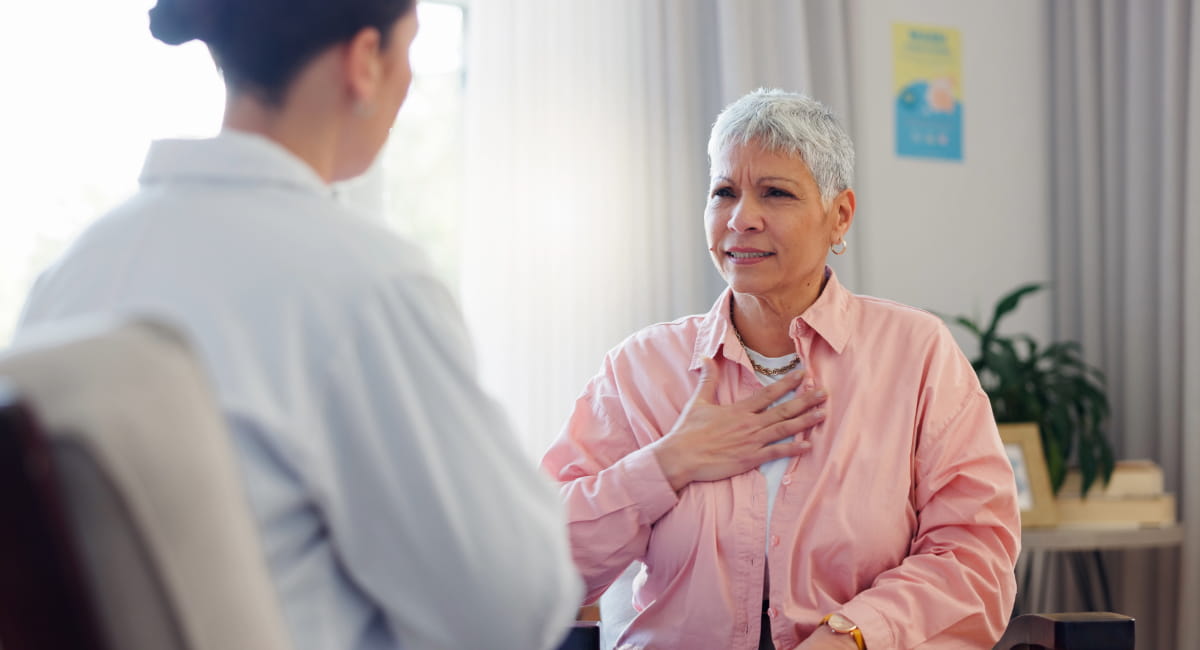“Every woman is different. Your family history, lifestyle and reproductive stage all influence what you should be monitoring, and when.”—Dr Judith Hammond, GP, Jean Hailes for Women’s Health
Key points
- Common women’s health issues include cardiovascular disease, cancer, reproductive and hormonal health, bone health and mental health.
- Midlife is often busy for women, but it’s also a crucial window for preventive care. Early and regular screenings can change outcomes.
- A trusted GP and clear plan can help you stay on top of your health and wellbeing.
Women are often the caregivers in their families—juggling jobs, relationships, children, ageing parents and more. But as Dr Judith Hammond, GP at Jean Hailes for Women’s Health, points out, this can mean they end up putting their own wellbeing last amid the mental load and multitasking.
“So many women in their 40s, 50s and 60s are focused on the people around them and they don’t prioritise their own health,” she says.
But midlife is a crucial time to focus on your own health, with regular check-ups and preventative care setting the foundation for decades to come.
So, what are the top health issues for women as they age, and how can you take control to build a good quality of life for yourself as you age and before issues become serious?
.jpeg)
How to build a preventative health plan as you age
When it comes to women’s health issues, prevention and early detection are key, especially as we age. From heart health to hormone shifts, many common conditions affecting women in their 40s and beyond are preventable or modifiable, but only if we’re looking out for them.
“We’re not just living into our 70s—we’re living into our 90s,” says Judith. “And so, from age 40, and particularly from age 50, we really need to start doing some regular maintenance. We want to live a positive and healthy life into our 90s, not a miserable one.”
That “regular maintenance” starts with understanding your individual risks, and the health risks women face more generally.
“Every woman is different,” says Judith. “Your family history, lifestyle and reproductive stage all influence what you should be monitoring, and when.”
She recommends working with a trusted GP to create a personal plan. That might include screening tests, targeted blood work, or conversations about contraception, fertility, perimenopause or menopausal hormone therapy.
“The more information women have about what’s relevant to them, the more they can advocate for themselves with their health professionals,” Judith adds.
What to check and when—a rough guide
It might seem scary at first, but creating a plan and sticking to it can actually help minimise stress and health anxiety, as tests and screening become routine. Plus, if anything does crop up, a solid screening schedule helps ensure you catch it early.
To get you started, here’s a basic guide to what women should be checking and when. However, bear in mind that this doesn’t take into account your personal circumstances or family history, so it’s always best to consult your GP:
- In your 40s: Check your blood pressure, cholesterol, mental health and skin. Continue cervical screening. Monitor changes to your period and discuss perimenopausal symptom support if necessary. Consider opting in to early breast and bowel screening, particularly after the age of 45.
- In your 50s: Add bone density and cardiovascular health checks. Consider hormone therapy or other support for menopause symptoms if appropriate, after discussion with health professionals. Don’t forget about eye health, dental and hearing checks, and diabetes screening.
- In your 60s and beyond: Continue monitoring heart, bone, breast and bowel health. Add cognitive health conversations.
Routine checks create a strong baseline. They also build confidence, because when you know your numbers, you can make informed decisions about any health risks you may face.
“I think what is really important for women from 40 onwards is to have a consultation with their GP about their overall health and their screening and what they should be doing,” says Judith.
“And, ideally, they would make a long appointment specifically for that purpose—rather than trying to squeeze it into a standard 15-minute consult on top of six or seven other issues.”

The most common women’s health challenges
Health concerns for women are shaped by hormones, genetics, life stages and social context. Here are some of the top women’s health issues after 40 and how to manage them early.
1. Cardiovascular disease
Heart disease is a leading cause of illness and death for Australian women, yet it’s still often seen as a “male” condition.
One reason is that women’s symptoms can be different—fatigue, nausea or breathlessness rather than chest pain. This can lead to underdiagnosis or late treatment.
“Many of the studies that were done in the past on cardiovascular disease were done on men, but we now know that women often present very differently with heart disease and that we need to be looking for different signs,” explains Judith. “Because although men tend to have a greater rate of cardiovascular disease pre-menopause, women catch up to men at menopause.”
High blood pressure, cholesterol and diabetes often develop without noticeable symptoms. That’s why regular heart checks from your 40s are vital, especially if you have a family history of heart disease, diabetes or are postmenopausal.
“If a person is really healthy, fit, with no family history, you might leave cardiovascular screening to the 50s onwards—but it doesn’t hurt to start monitoring blood pressure and cholesterol from your 40s, just so that you know where you arere at,” says Judith.
2. Cancer
Screening can feel confronting, but for many of the most common cancers affecting women, early detection is life-saving. Here’s what to know:
- Cervical: Screening is recommended every five years after age 25.
- Breast: Screen every two years from 50 to 74 via BreastScreen Australia. But you can opt in earlier and continue screening later if you want.
- Bowel: At-home kits are sent out every two years from age 45. However, once again, you can choose to opt in earlier.
If you are considered high-risk for certain cancers due to lifestyle factors or family history, you may need to start screening earlier, and more often. So always consult your GP.
“BreastScreen—the free breast screening service—will actually do a mammogram for women from age 40 if requested,” explains Judith. “They won’t automatically invite or recall you until age 50, but you can request a free mammogram every two years from age 40. And I normally suggest that women have at least one mammogram between the ages of 45 to 50, if not more.”
Meanwhile, on the cervical-screening front, self-tests are really shaking things up—in a good way.
“Cervical self-tests have changed things a lot, because you don’t have to put a speculum in, you don’t have to do an intimate examination if you don’t want to, and it’s so much easier to keep people up-to-date,” says Judith.
.jpeg)
3. Reproductive and hormonal health
From period changes and menopause in your 40s and 50s, hormonal shifts can bring a wide range of symptoms—including brain fog, hot flushes, anxiety and disrupted sleep.
“Perimenopause can start well in advance of your last period,” notes Judith. “It usually starts somewhere around the late 40s to early 50s, but could be earlier or later depending on the individual.”
If your symptoms are affecting your work, sleep, or mood, talk to your GP. Treatments might include hormone therapy, lifestyle adjustments or non-hormonal options.
4. Bone health
Osteoporosis is often called the “silent disease” because bone loss happens gradually—and isn’t obvious until a fracture occurs.
Resistance training exercise, calcium and vitamin D all play a role in prevention, according to Judith. But because oestrogen protects bone density, the risk of osteoporosis does increases significantly when levels of this hormone drop after menopause.
“The period around perimenopause and menopause is when you really want to be thinking about osteoporosis and maybe doing a baseline assessment for that with a bone-density scan,” explains Judith.
She adds that a bone density scan may be recommended from your 50s—particularly if you have risk factors like family history, low body weight or smoking. But notes that access may depend on cost as the cost is often not covered by Medicare.
5. Mental health and burnout
Mental health issues are common across all life stages, but they aren’t always openly discussed.
“We see a lot of emotional load in women, especially during perimenopause and menopause,” says Judith. “Juggling work, home and hormonal shifts—it’s no wonder many feel overwhelmed.”
Look out for changes in mood, energy, fatigue, sleep or concentration, and consider support options—including counselling, GP mental health care plans, lifestyle changes and community programs.
.jpeg)
Taking charge of your health
For many women, knowing where to start can feel overwhelming. That’s why having a clear plan—and a care team you trust—is so important.
“Prevention isn’t about doing everything at once,” says Judith. “It’s about taking small, regular steps and asking for support when you need it.”
Building strong relationships with your GP, allied health providers and community supports can make all the difference. Australian Unity also offers healthcare for women in Australia tailored to their needs, including preventative screenings, mental health and hormone management.
Because your health matters—and putting yourself first isn’t selfish. It’s smart, strong and essential.
“Midlife is often a time when women have got so many demands on them that their own issues are not their first priority,” says Judith. “But we have to encourage women to look after themselves—and to help them see that the healthier we keep them, the better able they will be to help their loved ones.”
Prioritise your health this Women's Health Week (1-7 September)
Many women prioritise others over themselves, but health shouldn’t take a back seat. Take the opportunity to focus on your health and wellbeing this Women’s Health Week.
Nine facts about women’s health
- Cardiovascular disease is the leading cause of death for Australian women.
- Women are three times more likely than men to experience anxiety.
- Around 90 percent of women experience perimenopausal symptoms, often for several years before menopause.
- One in six women in Australia lives with endometriosis.
- Osteoporosis affects one in four women over 75.
- Breast cancer is the most commonly diagnosed cancer in women.
- Many women experience delayed diagnoses for autoimmune and hormonal conditions.
- Only 55 percent of eligible women are up-to-date with cervical screening.
- Mental load and caregiving stress are significant but often under-recognised contributors to women’s health risks.


